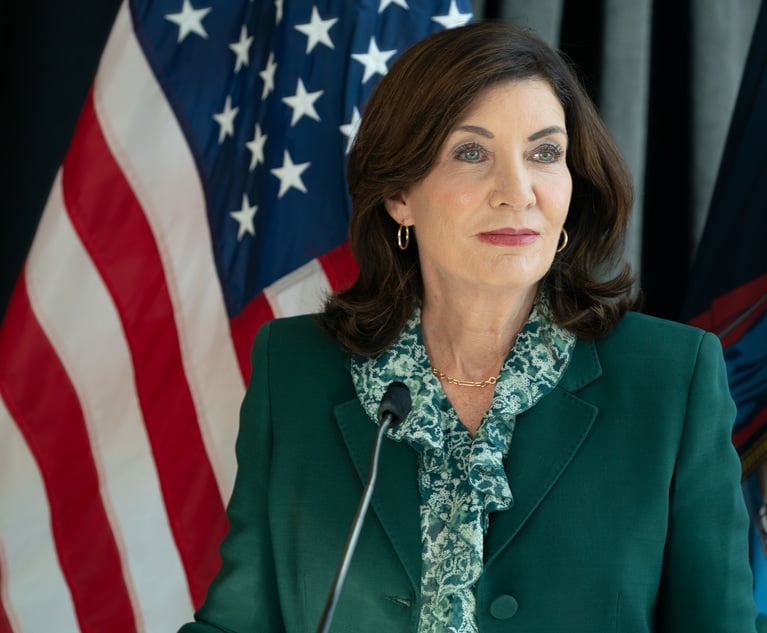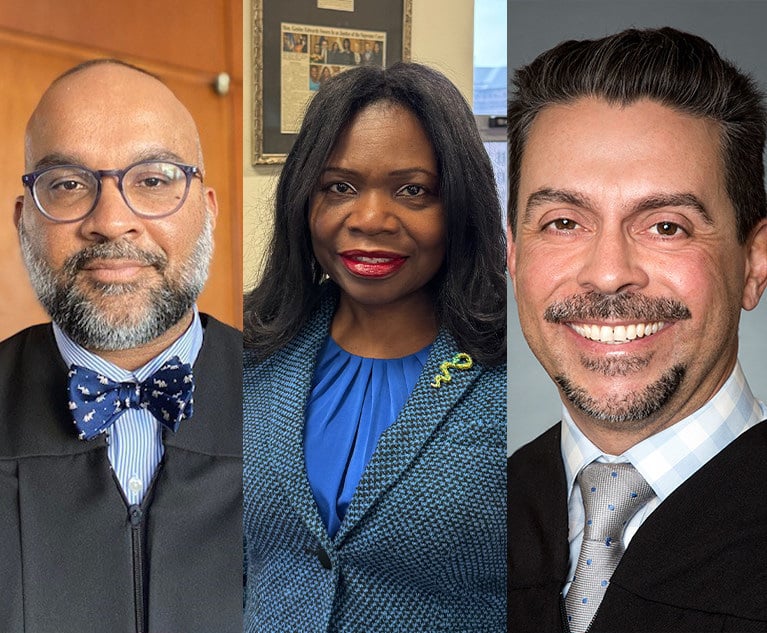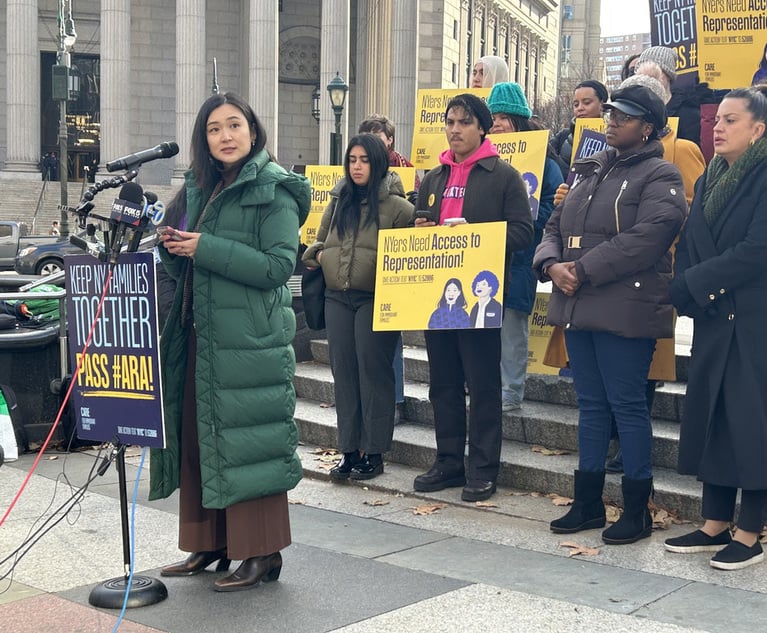New York State Legislature Passes Historic Act to Address Climate Change
This legislation will create a new, comprehensive regulatory program that will require a broad array of greenhouse gas emission sources to curtail their emissions in New York state.
June 26, 2019 at 01:00 PM
10 minute read

Both houses of the New York State Legislature recently passed the Climate Leadership and Community Protection Act (CLCPA or the Act), which Gov. Andrew Cuomo is expected to sign into law. This legislation will create a new, comprehensive regulatory program that will require a broad array of greenhouse gas (GHG) emission sources to curtail their emissions in New York state. Passage of the Act represents the culmination of a multi-year effort by NY Renews—a coalition of over 150 grassroots, state, and national organizations—to compel GHG reductions through legislation and to address the impacts of climate change and other pollution on disadvantaged communities. The legislation builds on New York state's significant leadership role in reducing GHG emissions by its creation of the Regional Greenhouse Gas Initiative (RGGI), and promotes renewable energy and energy efficiency through the New York State Energy Research and Development Authority (NYSERDA).
With the CLCPA, New York will join states and cities around the country that are in the process of adopting aggressive efforts to promote carbon reductions consistent with commitments agreed to by 195 countries in the 2016 Paris Agreement on climate change. These state and local efforts stand in stark contrast to the federal government's efforts to roll back Obama-era climate regulations, promote fossil fuel consumption, and withdraw from the Paris Agreement.
|New York's Net Zero Goal
The CLCPA sets forth an ambitious statewide objective of achieving “net zero” GHG emissions in New York by 2050. The Act establishes a binding and enforceable goal of 85% GHG emission reductions by 2050 (relative to 1990 levels), with an interim goal of 40% reductions achieved by 2030. To get to “net zero,” the remaining 15% of emissions could be eliminated through further direct emissions reductions or GHG offset projects such as ecosystem restoration. However, offsets would be credited only if they are verifiable, localized, and not required by other laws or programs.
The CLCPA also mandates dramatic shifts within the state's electricity generation industry, requiring 70% generation from renewable sources by 2030 and complete elimination of GHG emissions from the electric grid by 2040. Unlike other sources, electricity generators will not be permitted to reduce their emissions through offsets. To help reach the goal of a zero-emissions electric grid, the Act codifies the state's targets of installing six gigawatts of distributed solar energy by 2025; three gigawatts of energy storage capacity by 2030; and nine gigawatts of offshore wind by 2035.
|The Rationale for Action
The CLCPA's legislative findings speak not only to the need for action, but also to the benefits envisioned by the net-zero transformation that the Act mandates. To paraphrase the Act's preamble, the State Legislature found that climate change is adversely affecting the economic well-being, public health, natural resources and environment of the state, including an increase in the severity and frequency of extreme weather events; rising sea levels; a decline in freshwater and saltwater fish populations; increased average temperatures; exacerbation of air pollution; and an increase in disease and adverse public health outcomes. These impacts heighten the vulnerability of underserved communities, which disproportionately bear the environmental and socioeconomic burdens of pollution as well as the legacies of racial and ethnic discrimination.
The Legislature also found that climate action in New York will help reduce global GHG emissions and the rate of climate change; encourage other jurisdictions to implement complementary GHG reduction strategies; and provide an example of how to implement such strategies. The Legislature specifically recognized that the private sector is well positioned to advance the development of green technologies and sustainable practices with potentially far-reaching impacts, such as by lowering the costs of renewable energy and creating new jobs and tax revenues in New York. The state's response to climate change will include not only mitigation of GHG emissions but also the adoption of measures to improve the resiliency of the state with respect to unavoidable climate impacts and risks.
|Environmental Justice and Disadvantaged Communities
Considerations of equity and environmental justice are also at the forefront of the CLCPA. The Act calls for the convening of a Climate Justice Working Group, which will have an essential role in identifying Disadvantaged Communities through a public process. The legislation supports and focuses on these Disadvantaged Communities in many ways, including a commitment that 35-40% of the overall benefits and spending for clean energy and energy efficiency flow to these communities and that no further regressive impacts will affect them during the transition to a clean economy. In addition, the Act will prioritize green career opportunities and resources for members of these communities.
Co-pollutants, hazardous air pollutants that are concurrently released by a GHG-emitting source (e.g., sulfur dioxide from coal burning), receive special attention in the CLCPA. The distribution of co-pollutant “hot spots” has long been an environmental justice issue, and the CLCPA explicitly mandates the net reduction of co-pollutants in Disadvantaged Communities. The Act will require a robust Community Air Monitoring Program (CAMP) to be developed and deployed in communities with high cumulative exposure to air pollution. The data collected from the CAMP will be used by the New York State Department of Environmental Conservation (DEC) to design air pollution reduction programs to be implemented by subsequent regulations.
|Planning for the Clean Energy Transformation
The CLCPA calls for the creation of a Climate Action Council (the Council), a 22-member body which will consist of representatives from state agencies and political appointees. The DEC Commissioner and the President of NYSERDA will co-chair the Council. The Council is charged with preparing a Scoping Document that will be issued in draft form within two years and finalized within three years. The Scoping Document will serve as the basis for regulations to be issued within four years.
Recognizing that the transformation envisioned by the Act will involve complex legal, technical, economic and social issues, the legislation specifies that the Council will convene special advisory groups to provide expertise from various sectors, including transportation; energy-intensive and trade-exposed industries; land use and local government; energy efficiency and housing; power generation; and agriculture and forestry. A Just Transition Working Group will be empaneled to advise the Council on how to minimize economic disruption during the transition to a clean-energy economy, develop the next-generation labor force, and avoid adverse impacts to the competitiveness of the state's businesses and industries. The Council will also integrate the input of the Climate Justice Working Group created by the Act and a permanent DEC Environmental Justice Advisory Group.
Within one year of its formation, the Council must establish a statewide annual greenhouse gas emissions limit as a percentage of a 1990 baseline; this will form the basis for reductions thereafter. As part of that exercise, the Council may consider instituting a mandatory registry and reporting system for individual GHG-emitting sources in the state. Within one year of the effective date of the Act, DEC, in consultation with NYSERDA, is required to establish a social cost of carbon to be used by state agencies in future decisions and rulemakings. This measure is a monetary estimate of the value of not emitting one ton of GHG emissions. Similar efforts at the federal level were designed to help evaluate the costs that can be avoided by climate mitigation actions but were abandoned by the Trump Administration.
Within two years of being constituted, the Council is required to issue a draft Scoping Document outlining its recommendations about how best to attain the statewide GHG emissions limits. Although the Council has wide latitude to shape its recommendations, the Act requires the scoping plan to include at a minimum:
- Performance-based standards for sources of GHG emissions (including in the transportation, building, industrial, commercial and agricultural sectors);
- Measures to reduce GHG emissions in the electricity sector by increasing reliance on renewables and energy efficiency;
- Land use and transportation planning measures to reduce GHG emissions from motor vehicles;
- Measures to promote carbon sequestration and best management practices in land use, agriculture, and forestry;
- Measures to promote beneficial electrification of personal and freight transportation;
- Measures to reduce energy use in existing residential and commercial buildings;
- Recommendations to aid in the transition of the state workforce toward a clean energy industry;
- Measures to achieve healthy forests;
- Measures to limit the use of chemicals, substances, and products that contribute to global climate change; and
- Mechanisms to limit displacement of climate change impacts out of state as a result of in-state GHG reduction efforts.
At least six regional public comment hearings (three upstate and three downstate) will be held on the draft scoping plan along with a public comment period of at least 120 days. The scoping plan must be finalized one year after the draft plan is submitted.
Within four years of the Act's effective date, based on the Scoping Plan and further public consultations, DEC must issue regulations that will secure compliance with statewide greenhouse gas emission limits. Those regulations must ensure that aggregate emissions from GHG sources do not exceed each year's statewide limit; include legally enforceable emission limits, performance standards and other measures to control GHG emissions; and include measures to reduce GHG emissions from individual sources that have cumulative impacts on statewide GHG emissions, such as motor vehicles.
Thus, although the Act sets forth a broad framework for the scoping plan and eventual regulations, there is much work ahead to make the provisions of this legislation a reality. It will be challenging to design the provisions to achieve their stated GHG reduction objectives while also ensuring that they are equitable, minimize costs, and maximize benefits, as the Act requires.
|Significant Challenges and Opportunities Ahead
Once Governor Cuomo signs the CLCPA, New York will have legally committed itself to assume a leadership role in GHG mitigation and climate change adaptation. By doing so, the state will position its economy, technology centers, financial institutions, and businesses to benefit from national and international efforts to address climate change. In that sense, it charts a course toward the future that many New Yorkers believe is essential to our survival.
But implementing the Act will be extremely complex and challenging. The Legislature has created a lengthy public process with numerous opportunities to provide comment and help shape the future of our state's net-zero economy. Meaningful participation and input by all affected parties—from those in the private sector to environmental justice and other advocacy organizations to municipalities and government agencies—will be required throughout the process to ensure that the CLCPA is successfully implemented, while expanding the economy and creating new green jobs within New York state.
It is up to us as New Yorkers to make this groundbreaking Act a success.
Jeffrey Gracer is a principal at Sive, Paget & Riesel, P.C., the nation's first environmental law firm. Follow him on Twitter@jgracer. Kevin Rogers, a summer associate at the firm, assisted in the preparation of this article.
This content has been archived. It is available through our partners, LexisNexis® and Bloomberg Law.
To view this content, please continue to their sites.
Not a Lexis Subscriber?
Subscribe Now
Not a Bloomberg Law Subscriber?
Subscribe Now
NOT FOR REPRINT
© 2025 ALM Global, LLC, All Rights Reserved. Request academic re-use from www.copyright.com. All other uses, submit a request to [email protected]. For more information visit Asset & Logo Licensing.
You Might Like
View All
So Who Won? Congestion Pricing Ruling Leaves Both Sides Claiming Victory, Attorneys Seeking Clarification
4 minute read
Hochul Vetoes 'Grieving Families' Bill, Faulting a Lack of Changes to Suit Her Concerns

Court System Names New Administrative Judges for New York City Courts in Leadership Shakeup
3 minute read
Trending Stories
- 1Tensions Run High at Final Hearing Before Manhattan Congestion Pricing Takes Effect
- 2Improper Removal to Fed. Court Leads to $100K Bill for Blue Cross Blue Shield
- 3Michael Halpern, Beloved Key West Attorney, Dies at 72
- 4Burr & Forman, Smith Gambrell & Russell Promote More to Partner This Year
- 5Sanctions Order Over Toyota's Failure to Provide English Translations of Documents Vacated by Appeals Court
Who Got The Work
Michael G. Bongiorno, Andrew Scott Dulberg and Elizabeth E. Driscoll from Wilmer Cutler Pickering Hale and Dorr have stepped in to represent Symbotic Inc., an A.I.-enabled technology platform that focuses on increasing supply chain efficiency, and other defendants in a pending shareholder derivative lawsuit. The case, filed Oct. 2 in Massachusetts District Court by the Brown Law Firm on behalf of Stephen Austen, accuses certain officers and directors of misleading investors in regard to Symbotic's potential for margin growth by failing to disclose that the company was not equipped to timely deploy its systems or manage expenses through project delays. The case, assigned to U.S. District Judge Nathaniel M. Gorton, is 1:24-cv-12522, Austen v. Cohen et al.
Who Got The Work
Edmund Polubinski and Marie Killmond of Davis Polk & Wardwell have entered appearances for data platform software development company MongoDB and other defendants in a pending shareholder derivative lawsuit. The action, filed Oct. 7 in New York Southern District Court by the Brown Law Firm, accuses the company's directors and/or officers of falsely expressing confidence in the company’s restructuring of its sales incentive plan and downplaying the severity of decreases in its upfront commitments. The case is 1:24-cv-07594, Roy v. Ittycheria et al.
Who Got The Work
Amy O. Bruchs and Kurt F. Ellison of Michael Best & Friedrich have entered appearances for Epic Systems Corp. in a pending employment discrimination lawsuit. The suit was filed Sept. 7 in Wisconsin Western District Court by Levine Eisberner LLC and Siri & Glimstad on behalf of a project manager who claims that he was wrongfully terminated after applying for a religious exemption to the defendant's COVID-19 vaccine mandate. The case, assigned to U.S. Magistrate Judge Anita Marie Boor, is 3:24-cv-00630, Secker, Nathan v. Epic Systems Corporation.
Who Got The Work
David X. Sullivan, Thomas J. Finn and Gregory A. Hall from McCarter & English have entered appearances for Sunrun Installation Services in a pending civil rights lawsuit. The complaint was filed Sept. 4 in Connecticut District Court by attorney Robert M. Berke on behalf of former employee George Edward Steins, who was arrested and charged with employing an unregistered home improvement salesperson. The complaint alleges that had Sunrun informed the Connecticut Department of Consumer Protection that the plaintiff's employment had ended in 2017 and that he no longer held Sunrun's home improvement contractor license, he would not have been hit with charges, which were dismissed in May 2024. The case, assigned to U.S. District Judge Jeffrey A. Meyer, is 3:24-cv-01423, Steins v. Sunrun, Inc. et al.
Who Got The Work
Greenberg Traurig shareholder Joshua L. Raskin has entered an appearance for boohoo.com UK Ltd. in a pending patent infringement lawsuit. The suit, filed Sept. 3 in Texas Eastern District Court by Rozier Hardt McDonough on behalf of Alto Dynamics, asserts five patents related to an online shopping platform. The case, assigned to U.S. District Judge Rodney Gilstrap, is 2:24-cv-00719, Alto Dynamics, LLC v. boohoo.com UK Limited.
Featured Firms
Law Offices of Gary Martin Hays & Associates, P.C.
(470) 294-1674
Law Offices of Mark E. Salomone
(857) 444-6468
Smith & Hassler
(713) 739-1250






